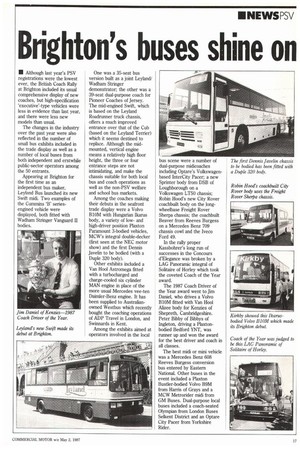Brighton's buses shine on
Page 19

If you've noticed an error in this article please click here to report it so we can fix it.
• Although last year's PSV registrations were the lowest ever, the British Coach Rally at Brighton included its usual comprehensive display of new coaches, but high-specification 'executive'-type vehicles were less in evidence than last year, and there were less new models than usual.
The changes in the industry over the past year were also reflected in the number of small bus exhibits included in the trade display as well as a number of local buses from both independent and erstwhile public-sector operators among the 50 entrants.
Appearing at Brighton for the first time as an independent bus maker, Leyland Bus launched its new Swift midi. Two examples of the Cummins 'B' seriesengined vehicle were displayed, both fitted with Wadham Stringer Vanguard II bodies. One was a 35-seat bus version built as a joint Leyland/ Wadham Stringer demonstrator; the other was a 39-seat dual-purpose coach for Pioneer Coaches of Jersey. The mid-engined Swift, which is based on the Leyland Roadrunner truck chassis, offers a much improved entrance over that of the Cub (based on the Leyland Terrier) which it seems destined to replace. Although the midmounted, vertical engine means a relatively high floor height, the three or four entrance steps are not intimidating, and make the chassis suitable for both local bus and coach operations as well as the non-PSV welfare and school bus markets.
Among the coaches making their debuts in the seafront trade display were a Volvo BlOM with Hungarian 'Icarus body, a variety of lowand high-driver position Plaxton Paramount 3-bodied vehicles, MCW's integral double-decker (first seen at the NEC motor show) and the first Dennis Javelin to be bodied (with a Duple 320 body).
Other exhibits included a Van Hool Astrornega fitted with a turbocharged and charge-cooled six cylinder MAN engine in place of the more usual Mercedes vee-ten Daimler-Benz engine. It has been supplied to Australianowned Westbus which recently bought the coaching operations of ADP Travel in London, and Swinnards in Kent.
Among the exhibits aimed at operators involved in the local bus scene were a number of dual-purpose midicoaches including Optare's Volkswagenbased InterCity Pacer; a new Sprinter body from DSB of Loughborough on a Volkswagen LT50 chassis; Robin Hood's new City Rover coachbuilt body on the longwheelbase Freight Rover Sherpa chassis; the coachbuilt Beaver from Reeves Burgess on a Mercedes Benz 709 chassis cowl and the Iveco Ford 49.
In the rally proper Kassbohrer's long run of successes in the Concours d'Elegance was broken by a LAG Panoramic integral of Solitaire of Horley which took the coveted Coach of the Year award.
The 1987 Coach Driver of the Year award went to Jim Daniel, who drives a Volvo B 10M fitted with Van Hool Alizee body for Kenzies of Shepreth, Cambridgeshire. Peter Bibby of Bibbys of Ingleton, driving a Plaxtonbodied Bedford YNT, was runner up and won the award for the best driver and coach in all classes.
The best midi or mini vehicle was a Mercedes Benz 608 Reeves Burgess conversion bus entered by Eastern National. Other buses in the event included a Plaxton Bustler-bodied Volvo B9M from Harris of Grays and a MCW Metrorider midi from GM Buses. Dual-purpose local buses included a coach-seated Olympian from London Buses Selkent District and an Optare City Pacer from Yorkshire Rider.




























































































































